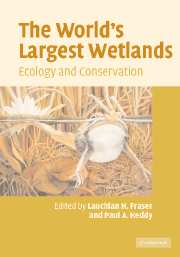Book contents
- Frontmatter
- Contents
- List of contributors
- Preface
- 1 Introduction: big is beautiful
- 2 The West Siberian Lowland
- 3 The Amazon River basin
- 4 The Hudson Bay Lowland
- 5 The Congo River basin
- 6 The Mackenzie River basin
- 7 The Pantanal
- 8 The Mississippi River alluvial plain
- 9 The Lake Chad basin
- 10 The River Nile basin
- 11 The prairie potholes of North America
- 12 The Magellanic moorland
- 13 The future of large wetlands: a global perspective
- Index
- References
13 - The future of large wetlands: a global perspective
Published online by Cambridge University Press: 10 August 2009
- Frontmatter
- Contents
- List of contributors
- Preface
- 1 Introduction: big is beautiful
- 2 The West Siberian Lowland
- 3 The Amazon River basin
- 4 The Hudson Bay Lowland
- 5 The Congo River basin
- 6 The Mackenzie River basin
- 7 The Pantanal
- 8 The Mississippi River alluvial plain
- 9 The Lake Chad basin
- 10 The River Nile basin
- 11 The prairie potholes of North America
- 12 The Magellanic moorland
- 13 The future of large wetlands: a global perspective
- Index
- References
Summary
Introduction
It is a difficult task to write the concluding chapter of The World's Largest Wetlands because one could imagine two quite different audiences drawn to this book. Some will know a great deal about wetland science and will probably use the book for the many examples and descriptions of large wetland systems offered. Others may be encountering the science of wetland ecology for the first time, and perhaps may not have the academic resources readily at hand to interpret the content, or to draw common parallels between the large wetland systems. In reviewing these chapters and considering the two audiences, we constructed four themes that are shared across chapters: (1) threats to wetlands; (2) efforts to save wetlands; (3) wetlands, water, and humans; and (4) moving toward conservation. For somebody already well-versed some, or even all, of this summary may not be needed; but for others it will be a helpful capstone to the discussion of large wetland systems. Keep in mind that there are other wetlands books with much more detail that the reader should go to for a more-thorough reference.
The estimated annual value of wetlands, based on ecosystem services and natural capital, is US$12790 trillion (Constanza et al. 1997); this accounts for over one-third of the total value for the world. Much of the value associated with wetlands is related to the role they play in the hydrological cycle (e.g. water storage and water quality).
- Type
- Chapter
- Information
- The World's Largest WetlandsEcology and Conservation, pp. 446 - 468Publisher: Cambridge University PressPrint publication year: 2005
References
- 12
- Cited by



